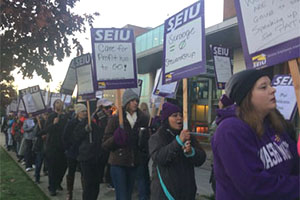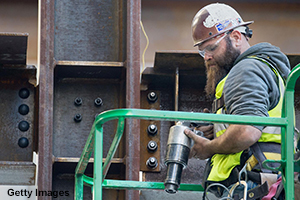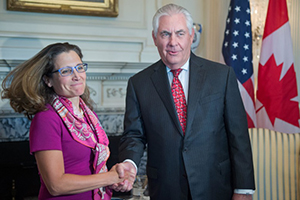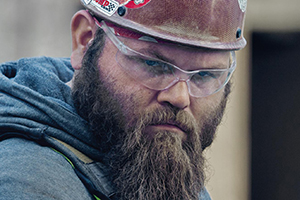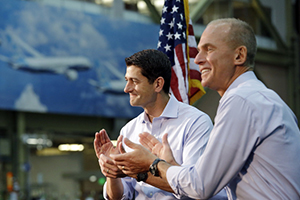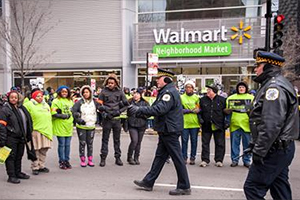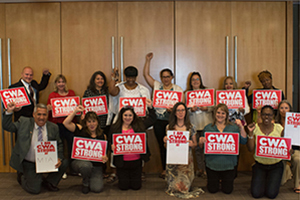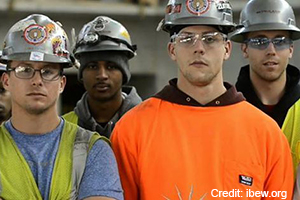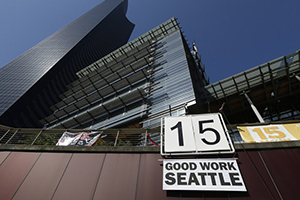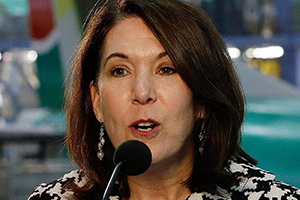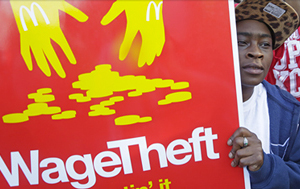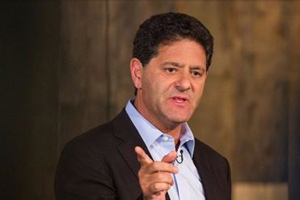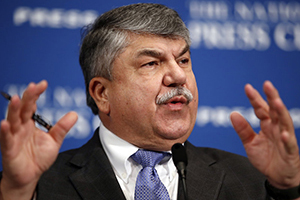2017 Local Labor News
Click on link for past labor news articles: 2006 | 2007 | 2008 | 2009 | 2010 | 2011 | 2012 | 2013 | 2014 | 2015 | 2016 | 2018 | 2019
Published December 27, 2017 in TheStand.org
Ads warn of GOP plan to cut Social Security, Medicare

Labor-sponsored ads cite Republican leaders’ intention to cut ‘entitlements’ to pay for tax cuts for the rich
The Washington State Labor Council, AFL-CIO, along with some of its affiliated unions and retiree advocacy groups, sponsored full-page ads today in newspapers in the state’s four districts with Republican members of Congress. The ads point out that Republican leaders intend to cut Social Security and Medicare benefits to help pay for their trillion-dollar plan to cut taxes for the wealthy and corporations, and urge readers to call their representative and tell him or her to vote against the tax plan that’s expected to face a final vote in the coming days.
“Republican leaders have made it clear that this irresponsible tax giveaway for people who need it the least will require cuts in spending and they have their sights set on what they call our Social Security and Medicare ‘entitlements’,” said WSLC President Jeff Johnson. “Those are earned benefits that working people paid for their entire lives. It would be a travesty for Congress to hand more than $1 trillion to corporations and the richest Americans, and then cut these earned benefits that seniors rely upon to survive. But that’s exactly what they intend to do.”
TAKE A STAND — Click here to call to your Representative now or dial 1-844-899-9913 toll-free and you’ll be connected to your Representative. Tell them to vote NO on this tax-cutting plan and to keep their HANDS OFF the Social Security and Medicare benefits that you have earned.
In addition to the WSLC, the newspaper ads are sponsored by the Washington State Alliance for Retired Americans, Puget Sound Advocates for Retirement Action, Retired Public Employees of Washington, American Federation of Teachers-Washington, Machinists 751, SEIU 1199NW, Teamsters 117, UFCW 21, Washington Education Association, Washington Federation of State Employees/AFSCME, and the regional Central Labor Councils in each of the congressional districts. The ads appear in today’s editions of the (Spokane) Spokesman-Review, (Vancouver) Columbian, Wenatchee World, and Yakima Herald-Republic. Read entire article
Published December 23, 2017 in The Washington Post
‘I Hope I Can Quit Working in a Few Years’: A Preview of the U.S. Without Pensions
By Peter Whoriskey
 Tom Coomer has retired twice: once when he was 65, and then several years ago. Each time he realized that with just a Social Security check, “You can hardly make it these days.”
Tom Coomer has retired twice: once when he was 65, and then several years ago. Each time he realized that with just a Social Security check, “You can hardly make it these days.”
So here he is at 79, working full-time at Walmart. During each eight-hour shift, he stands at the store entrance greeting customers, telling a joke and fetching a “buggy.” Or he is stationed at the exit, checking receipts and the shoppers that trip the theft alarm.
“As long as I sit down for about 10 minutes every hour or two, I’m fine,” he said during a break. Diagnosed with spinal stenosis in his back, he recently forwarded a doctor’s note to managers. “They got me a stool.”
The way major U.S. companies provide for retiring workers has been shifting for about three decades, with more dropping traditional pensions every year. The first full generation of workers to retire since this turn offers a sobering preview of a labor force more and more dependent on their own savings for retirement. Read entire article
Published December 17, 2017 in The Washington Post
Trump Administration’s Plan for Cutting Federal Compensation, Potentially Even Paid Holidays
By Joe Davidson
The Trump administration’s consideration of a wage freeze for federal employees is one piece of a renewed multifront Republican push to shrink those workers’ pay, benefits and workforce.
That effort has been around for years, but it now has an intellectual champion in the White House, and I don’t mean President Trump.
Confidential administration information released last week by Sen. Claire McCaskill (Mo.), the leading Democrat on the Senate Homeland Security and Governmental Affairs Committee, revealed an administration proposal to freeze federal salaries in fiscal 2019. That is the third piece in a pattern that includes Trump’s 2018 budget proposal to cut the employer contribution to retirement benefits and the House Republican plan to have retirees pay more out of pocket for their health insurance.
Congress did not approve the last two recommendations, and the pay freeze, which Trump can impose, is not beyond the leaked-document stage. Yet the proposals lurk, likely to reemerge in future budget plans after having long percolated in conservative circles.
Now, with James Sherk — a chief proponent of the notion that federal workers are overpaid — serving as Trump’s labor adviser, the proposals stand their best chance yet of becoming policies that dig deep into federal employees’ pockets. Read entire article
Published December 11, 2017 in TheStand.org
Providence Workers STRIKE!
EVERETT (Dec. 6, 2017) — After taking action for more than a year to call on Providence Home Health Care and Hospice of Snohomish County to invest in patient care, the 230 nurses, social workers, chaplains, OTs, PTs, hospice aides, and speech therapists began an Unfair Labor Practice strike today. The caregivers will rally with community supporters tonight at 4:30 p.m. at Everett’s Wetmore Theater Plaza.
“It feels like the agency is being run as a business with less concern for the key people the Providence sisters lifted up in their mission,” said John Shannon, a Social Worker with Providence Home Care of Snohomish County. “We as caregivers strive to care and be present with our patients and our values—that’s why we have no choice but to strike.”
Caregivers are calling for more time to spend with patients, more reasonable on-call time to allow them to be more alert with patients, and improved wages to address high turnover that impacts the continuity of care. The agency provides end-of-life care in inpatient or wherever patients live as well as healthcare support for in-home patients but caregivers report being rushed from one patient to the next. Providence St. Joseph Health, the agency’s parent corporation with 50 hospitals and more than 800 clinic facilities, made $64 million in profit in 2016.
“Providence has become a huge corporation determined to turn a deaf ear to our concerns. We who provide care bring our skills, our hands, and our hearts to our patients every day,” said Cynthia Robson, a Masters in Social Work in the Hospice. “It’s time for Providence to work with us so we can provide the BEST care to every patient, every time.”
Caregivers have already participated in community leafleting, an informational picket, petition gathering, and other actions in their ongoing effort to come to a resolution that puts patient care first. Despite eleventh hour bargaining yesterday, Providence has failed to bring proposals to the table that would invest in patient care and respect the experience and compassion of the caregivers.
“A strike is the last thing we want to do, but Providence has been unwilling to listen to our voices,” said Florence Gustafson, RN. “We’re here for our patients, and that means taking action to hold Providence accountable to patient needs and to how Providence treats its staff.”
Picketing will take place daily during the agency’s business hours, 6:45 a.m. until 5 p.m. A community rally is planned for tonight, December 6, at 4:30 p.m. at Wetmore Theater Plaza in Everett.
http://www.thestand.org/2017/12/providence-workers-strike
Published December 11, 2017 in Newsweek
We Need Stronger Labor Unions to Protect the Middle Class
BY SHARON BLOCK
Labor law in our country is profoundly broken.
The National Labor Relations Act is the federal statute that protects the right of employees to join a union, engage in collective bargaining or just stand together with coworkers to have a say in what happens at work.
Congress passed the law in 1935 to “ encourage collective bargaining.” But the NLRA is failing to fulfill this purpose. Its failure can be summed up in one surprising statistic : the percentage of American workers who are members of unions is lower now than before the NLRA passed.
Think about that; workers were more likely to be union members (13.2 percent) when they had no right to do so than they are now (10.7 percent) after more than 80 years of having a federally protected right.
This decline is having a dramatic effect on all American workers – because the decline in union density suppresses wages for all workers, it accounts for about one-third of income inequality over the past several decades.
The NLRA needs a major overhaul. Recent efforts to amend it have been more in the category of tinkering with than rewriting the rules.
The last major effort to amend the NLRA came at the beginning of the Obama Administration with a push to pass the Employee Free Choice Act, a bill which would have changed how workers choose a union but that left the basic structure of the law intact.
Looking back on it, EFCA was the legal equivalent of bringing a knife to an Uzi fight.
I don’t come to this conclusion easily. During the EFCA fight, I worked for Senator Edward M. Kennedy, who led the ultimately unsuccessful legislative battle for the bill. But changes in the American economy and the growing willingness of employers to flout the law dictate that we now look for bigger, bolder solutions. Read entire article
Published November 6, 2017 in The New York Times
Competition Is Ruining Childhood. The Kids Should Fight Back.
By Malcom Harris
 Like the crack of a starting pistol, November begins the official college application season. But for students, this race started long ago.
Like the crack of a starting pistol, November begins the official college application season. But for students, this race started long ago.
Many of today’s kids have lived their entire lives, from sunup until midnight, in a fierce tournament with their peers. (I was one of them. A decade after graduation, I still can’t think of a period when I’ve worked harder than in high school.) From kindergarten to 12th grade, schools brag about how “competitive” they are. That means it’s not enough for students to do their best. Whether in the classroom, on the athletic field or at home on the computer, they must always be better. Youth has become a debilitating endurance test.
The thing is, we don’t even really know what we are racing for, much less how to tone down the competition. And most people don’t seem to be benefiting from this frantic contest, either as students or as adult workers. Americans are improving themselves, but the rewards keep flowing uphill to the 1 percent.
Everyone tells students that the harder they work to develop their job skills — their “human capital” — the better off they will be. It’s not true. In fact, the result is the opposite: more and better educated workers, earning less.
An analysis in September of Census Bureau data by the Economic Policy Institute, a think tank, found that between 2000 and 2016 — years when many millennials first entered the job market — there was “little to no gain” in median annual earnings. This isn’t some limited fallout from the 2008 financial crisis; it’s a different type of phenomenon and part of a longer trend of wage stagnation that reaches back to the 1970s.
Educational achievement, on the other hand, follows a different trend. According to the National Center for Education Statistics, over the same period (2000 to 2016), the percentage of young people with a high school diploma or its equivalent passed 90 percent for the first time. In the same period, the portion of graduates seeking and obtaining both two- and four-year degrees increased consistently, and the percentage of people ages 25 to 29 with postgraduate degrees jumped to 9 percent from 5. Read entire article
Published October 5, 2017 at teamsters174.net
Puerto Rico Hurricane Relief Update
October 5th, Local 174 Safeway member Ben Narayan and Safeway Senior Business Agent/Recording Secretary Carl Gasca began their first full day of hurricane relief in Puerto Rico — though their actual work began many hours ago. They both worked the night shift bringing much-needed food and baby supplies to hard-hit areas of the island, and have been working nonstop ever since.
“Morale is great. Everyone is excited to be here and excited to be helping. Operators, Laborers, and Teamsters are all working together with the local municipalities to clean up San Juan. And the Teamsters are leading the way,” Gasca said this morning.
When asked what they had him doing, he said “everything. I’m in a dump truck right now hauling debris. So is Ben.”
“So to everyone at the Local who said I had been a Business Agent too long and couldn’t drive a truck anymore — why don’t you come on down here and say that?” he joked. He said the accommodations were about as expected, with cots and warm showers.
“The humidity is unbearable, but we are roughing it in good spirit. There are great people from all over the country — nurses, doctors, people from every trade.” Read entire article
Published September 14, 2017 at governing.com
Incomes Are Rising in Most States, Yet Inequality Isn't Improving
The nation's median household income rose 2.4 percent last year, with significant increases in 30 states.
By Mike Maciag
Americans' incomes continued trending upward in 2016, according to new U.S. Census Bureau estimates released on Thursday. That’s good news for employees, local economies and governments that rely on income tax revenues. But despite the bigger paychecks, inequality has not improved.
Nationally, median household incomes ticked up 2.4 percent after adjusting for inflation, marking the fourth consecutive significant increase in the Census Bureau's American Community Survey (ACS). In all, real incomes rose in 46 states last year, with the increases in 30 states enough to be considered statistically significant.
Idaho recorded the strongest growth, with incomes up 6.3 percent from 2015. The state also had the largest percentage increase in jobs last year as construction, agriculture and financial services propelled its economy. Not too far behind were Massachusetts, where incomes increased 5.8 percent, along with Oregon (5.1 percent) and North Carolina (4.5 percent). Read entire article
Published September 10, 2017 on q13fox.com
Snohomish PUD workers Heading to Help with Hurricane Irma Relief
Workers from Snohomish County P.U.D. left Sunday morning to help with hurricane relief in Florida and Georgia.
Nineteen electrical workers are on their way to help at least 2.3 million people who lost power because of Hurricane Irma. More people are expected to lose electricity as the hurricane makes its way up Florida’s gulf coast.
“I’ve never been in such big storm repair setting and I know there’s always a need for extra help and this is what I’ve been trained to do,” Mark Hasko told Q13 News. “I have the skill and the time available to do that, and my wife said ‘yes.’ She’s ok with me going, which is important, and just an opportunity to help those who need it.”
Hasko and his colleagues will begin in Georgia where the teams will be told where to go from there.
http://q13fox.com/2017/09/10/snopud-workers-heading-to-help-with-hurricane-irma-relief/
September 5, 2017 at Slate.com
Canada Reportedly Wants the U.S. to Scrap Its Right-to-Work Laws as Part of a New NAFTA Deal
By Jordan Weissmann
Canadians are apparently sick of competing with nonunionized foreign workers South of the border. According to the Globe & Mail, the country’s negotiating team is asking the United States to scrap its anti-union right-to-work laws as part of an updated North American Free Trade Agreement, presumably in order to prevent poorly paid Americans from undercutting organized Canadian labor on wages. Obviously, this is not what the Trump administration had in mind when it demanded our neighbors return to NAFTA’s negotiating table.
Right-to-work statutes allow employees to opt out of paying fees to the unions that represent them in collective bargaining. These laws are frequently blamed for draining organized labor of financial resources and have likely contributed to the decline of union organizing over the past several decades. States are permitted to enact the laws under the Taft-Hartley Act of 1947, a landmark piece of union-busting legislation that congressional Republicans passed over President Harry Truman’s veto. Canada, which like the U.S. is seeking to strengthen NAFTA’s labor protections overall, would reportedly appreciate it if Washington would pass new federal legislation banning right-to-work provisions.
“I’m very pleased with the position the Canadian government is taking on labour standards,” Jerry Dias, president of Canada’s largest private-sector union, told reporters outside of this weekend’s NAFTA talks. “Canada’s got two problems: The low wage rates in Mexico and the right-to-work states in the United States.”
To be clear, there is zero chance that a Republican White House would agree to do away with right-to-work laws as part of a trade deal. Breaking the power of organized labor is a key piece of the party’s long-term agenda, and relinquishing that goal in order to appease our lefty neighbors would cause an uproar among the GOP donor class. Canada almost surely knows this, and is staking out an extreme negotiating position in order to signal that it’s treating these talks seriously and is prepared to ask for major concessions.
It’s also an ironic way to throw the Trump administration’s protectionist rhetoric back in its face, which seems like part of the point. Read entire article
Published August 28, 2107 at www.newsweek.com
Robert Reich: On Labor, Tragically, Trump Was Right
Uh, Mr. Speaker? I hope you looked around on your Seattle visit. Because there’s probably no place where big business is less in need of a big tax break. And no company that’s already had more than its fair helping of them than Boeing.
By Robert Reich
This will be the first Labor Day of the presidency of Donald J. Trump, who came to office riding a wave of anti-establishment anger from average working people. No one can say they didn’t see it coming.
By the time Trump was elected, the typical American household had a net worth 14 percent lower than the typical household in 1984. The richest 1 percent owned more than the bottom 90 percent.
Last year’s annual Wall Street bonus pool alone was larger than the annual year-round earnings of all 3.3 million Americans working full time at the federal minimum wage of $7.25 an hour.
While 90 percent of US adults born in the early 1940s were earning more than their parents by the time they reached their prime earning years, only half of adults born in the mid-1980s are earning more than their parents in their prime earning years.
Most also have less economic security than their parents. Nearly one out of every five American workers is in a part-time job. Two-thirds are living paycheck to paycheck. Read entire article
Updated August 27, 2107 at www.seattletimes.com
Paul Ryan Picked the Most Awkward Spot in America to Argue for Corporate Tax Cuts
Uh, Mr. Speaker? I hope you looked around on your Seattle visit. Because there’s probably no place where big business is less in need of a big tax break. And no company that’s already had more than its fair helping of them than Boeing.
By Danny Westneat
Seattle Times staff columnist
U.S. House Speaker Paul Ryan couldn’t, or more likely, wouldn’t, believe his own eyes.
There he was, smack dab in the middle of Boeing’s 787 rocking production lineup in Everett, inside the largest manufacturing facility in the world. Place was humming.
“I’ve never seen anything like this my entire life,” he gushed.
But then, channeling his inner Ayn Rand, Ryan launched into boilerplate about what a miracle it was that Boeing can even get out of bed in the morning, what with the hellscape of taxes it faces from the government.
“For Boeing, we are taxing this business, these planes, your jobs in this country at a much higher tax rate than our foreign competitors tax theirs,” the Republican said. “You know what the tax rate here is? Thirty-five percent! “
Gesturing at the activity in the plant, he added: “I’m just in awe that in spite of all that, you’re still doing so well.”
Inconveniently well! Boeing’s on a roll of huge profits and back jet orders, with its stock up 50 percent for the year. When Boeing last reported its earnings, analysts were also in awe — and not at its tax burdens.
“Monster cash flow,” said one. “Boeing: stunning,” summed up another. Read entire article
Published July 28, 2017 at www.teamsters117.org
Solidarity at Fred Meyer - Members Vote 332-1 to Authorize a Strike
Posted by Paul Zilly
The grocery giant Fred Meyer/Kroger has a history of testing our members’ resolve.
In 2011 and 2014, they put substandard proposals on the table that were insufficient to meet the needs and demands of the membership and rejected by the Teamster 117 bargaining committees.
During those contract cycles, Fred Meyer members refused to be intimidated. They passed critical strike votes by wide margins, distributed leaflets in several states, engaged the media, and rallied for a fair contract.
Now, history is repeating itself. The company is refusing again to maintain industry standards by insisting on an offer that is inferior to the contract recently ratified by our members at Safeway.
But just like in the past, Local 117 members at Fred Meyer are not backing down. Today, in meetings at the Teamsters 313 hall in Tacoma, the group voted 332-1 to reject the company’s latest offer. In doing so, they overwhelmingly authorized a strike. Read entire article
Published July 26, 2017 at www.alternet.org
The Shocking, Unmatched Pains That Wal-Mart Took to Avoid Unions
Wal-Mart managers were supposed to contact corporate headquarters the moment they sniffed even a hint of union activity to get support in quashing labor reform.
The following is an excerpt from the new book The End of Loyalty: The Rise and Fall of Good Jobs in America by Rick Wartzman. Copyright © 2017. Available from PublicAffairs, an imprint of Perseus Books, LLC, a subsidiary of Hachette Book Group, Inc. Also available for purchase from Amazon and IndieBound.
One reason that Wal-Mart workers have always had difficulty improving their lot is that they’ve never been able to form a union. At its core, Wal-Mart’s rationale for being against organized labor was not unlike that of Kodak, say, or General Electric under Lem Boulware: management had an open door policy, by which any worker could ostensibly walk in and discuss anything. Therefore, as Wal-Mart laid out in its “Manager’s Toolbox to Remaining Union Free,” “we do not believe there is a need for third-party representation. It is our position every associate can speak for him/herself without having to pay his/her hard-earned money to a union in order to be listened to and have issues resolved.”
Yet unlike Kodak, which tried to frustrate union organizers by keeping its workers happy with good wages and princely benefits, Wal-Mart has been reliably ungenerous. And unlike GE, which fought tooth and nail against the International Union of Electrical Workers but ultimately honored its right to exist, Wal-Mart has never allowed so much as a single one of its stores to be organized. Indeed, ever since Mr. Sam’s time, the company has done everything it can to crush the unions, painting them in the most Manichean terms. They are “nothing but blood-sucking parasites living off the productive labor of people who work for a living!” said attorney John Tate, an iron-willed right-winger whom Walton had hired to help beat back the Retail Clerks in the early 1970s and who then stuck around at Wal-Mart where he developed an array of anti-union techniques. Read entire article
Published June 29, 2017 at cwa-union.org
Passenger Service Agents Lobby Congress to Strengthen Assault Protections
American Airlines and Envoy Passenger Service Agents from across the country gathered in Washington D.C. to lobby Congress on strengthening protections for passenger service agents in the FAA Reauthorization bill.
With the high tensions that are increasingly common with air travel, Passenger Service Agents face numerous challenges at work, including dangerous situations like verbal and physical assault from passengers. Passenger Service Agents have reported being verbally and physically assaulted by customers, including being hit, having luggage and equipment thrown at them, being pulled over counters, and getting spat upon.
Zuzana Uhnakova, a Passenger Service Agent from Miami with American Airlines, said that the meetings with Members of Congress and their staff were productive. "Now they are aware of what is really happening to us. In December, I was assaulted by a passenger. We've been verbally abused every day. I'm here not only for myself, but for every agent."
Heyda Delgado, an American Airlines Passenger Service Agent from San Juan, said, "They were surprised that the law isn't taking us seriously. They aren't seeing what goes on behind the scenes. They were very receptive."
https://www.cwa-union.org/news/passenger-service-agents-lobby-congress-strengthen-assault-protections#.WV2yK7v_Z9c.facebook
Published at electricianapprenticehq.com
How To Join The IBEW Apprenticeship Program - The 5 Step Process
1. Decide Which Program Is Right For You
The first thing is to find an IBEW apprenticeship and learn about the training programs they offer.
Choices can include:
• Outside Lineman
• Inside Wireman
• Technician (Sound & Communication)
• Residential Wireman
For example, the Puget Sound Electrical JATC in Renton, WA offers three programs: Construction Apprentice (inside wireman), Sound and Comm (technician), and Residential.
Not every apprenticeship offers all these programs. The outside lineman apprenticeship is only offered at training centers specifically tailored to that program.
Wages for an apprentices are based on a percentage of Journeyman scale – first year apprentices can expect around 50%. However, wages increase in increments about every 6 to 12 months or 1000 hours of work completed.
Wages also fluctuate between each IBEW apprenticeship, local unions, from city to city, and state to state.
The west coast and upper east coast apprentices earn higher wages than those in the south – but you must remember the cost of living is must higher in those areas as well. Read more
Published June 30, 2017 at www.slate.com
Horizon Air Is Canceling Hundreds of Flights Because of the 'Pilot Shortage' It Helped Create
By Daniel Gross
On the one hand, we’re told, robots are coming to take all our jobs any day now. But then there are 6 million job openings in the U.S., and large companies in a range of industries are telling us they are running out of humans to perform labor.
The reality, of course, is somewhere in between. Automation is substituting for human labor in ways large and small. The productivity engine isn’t completely broken. The volume of coal mined this year is up 17 percent, though employment in coal mining is up only two 2 percent. But American companies don’t have a shortage of people. They have a shortage of wages, benefits, and training. Companies could fix that problem, but they haven’t.
Take Horizon Air, a regional airline that services the Pacific Northwest, which the Seattle Times reports is “cutting its flight schedule this summer because of a severe shortage of pilots for its Q400 turboprop planes. The shortage became a crisis this past month when Horizon was forced to cancel more than 318 flights because it didn’t have enough pilots to fly all its planes.” That represents 6.2 percent of the flights Horizon runs between Seattle and places like Boise, Spokane, and Portland.
Think about that. Flying these routes isn’t some ancillary or side business for Horizon. It’s the only business it is in. Canceling flights is damaging to your brand and your company’s long-term prospects—it alienates and annoys customers who have already purchased tickets. And it’s damaging to your short-term profits. You’re in the business of moving people from point A to point B, the more you can move the better. You’re already committed to pay for the overhead—the planes, insurance, the gate slots at airports, the maintenance, and the ground crews. You need volume to be as high as it can. Choosing not to run flights that have paying passengers is an enormous own goal. It’s the equivalent of Starbucks deciding not to open several hundred stores for which it is paying rent because it doesn’t have enough managers. Read entire article
Published June 28, 2017 in Minneapolis Star Tribune
$15 Minimum Wage: Study Was Flawed; Minneapolis Should Still Follow Seattle's Lead
With the Minneapolis City Council set to vote on a $15-an-hour minimum wage as early as Friday, you can expect business lobbyists to tout a controversial new report from the University of Washington (http://bit.ly/2s8Co31) that purports to show Seattle’s groundbreaking move toward a $15-an-hour minimum wage cost the city jobs. Ignore the chicken littles. The sky is not falling in Seattle, and the report itself is fatally flawed. It’s also directly contradicted by a much more credible study released by the University of California, Berkeley, last week (http://bit.ly/2s27SE4) confirming that Seattle’s minimum wage is working: boosting worker pay without hurting the city’s dizzying job growth.
First, what’s not disputed: Since Seattle approved its $15 minimum wage (being raised incrementally, reaching the full amount in 2021), the city’s unemployment rate has fallen to a historic low of 2.6 percent, and jobs have grown in a few years from 510,000 to about 550,000. Pay has been rising at every level in Seattle’s hot labor market, as employers facing labor shortages compete for workers.
Using state-of-the-art research methods, the UC study focused on Seattle’s restaurant industry — the largest low-wage sector where any negative impact from the minimum wage most likely would be evident. It compared pay and job growth patterns from 2009 through 2016 with a composite constructed from comparable metropolitan economies across the U.S. After controlling for many other factors in Seattle’s and the national economy, the comparison shows that pay in Seattle’s food-service industry increased by nearly 1 percent overall and by 2.3 percent in limited-service restaurants such as fast-food franchises. Those findings are what you would expect, since the Seattle minimum wage went up faster for large employers such as limited-service fast-food chains. Read entire article
Published May 26, 2017 in The Seattle Times
Aerospace Tax Incentives Saved Boeing $242 Million Last Year
By Dominic Gates
Seattle Times aerospace reporter
Boeing disclosed Friday that last year it saved $242 million thanks to Washington state’s aerospace industry tax incentives, $63 million less than the previous year. The figures indicate Boeing paid $68 million in B&O tax, the major portion of its state and local tax bill.
Boeing disclosed Friday that last year it saved $242 million thanks to Washington state’s aerospace-industry tax incentives.
That’s $63 million less than its state tax savings in 2015.
The major elements of the tax savings were:
• $100 million from the 40 percent reduction in the Business & Occupation (B&O) tax rate.
• $82 million from B&O tax credits for activities related to setting up production equipment for the new 777X and the 737 MAX jets.
• $23 million in a Sales & Use tax exemption for the purchase of construction material.
Boeing did not disclose how much tax it actually paid in Washington state, but a portion of the taxes paid can be deduced. Read entire article
Published June 14, 2017 in the Tacoma News Tribune
Boeing Continues to Pare Washington Workforce, Plans to Shift Hundreds of Jobs to Arizona
By Dominic Gates
The Seattle Times
Boeing plans to transfer yet another substantial work group out of the Puget Sound region, the company confirmed Wednesday. The work shifting to Mesa, Ariz., could involve hundreds of jobs.
The changes are coming at Boeing’s Shard Services Group (SSG), which employs about 3,000 people in the Puget Sound region and provides a wide range of support services to Boeing’s corporate and production units.
The unit’s leadership has initiated a sweeping review and has begun to inform specific groups that their work is pegged for moving.
It’s part of Boeing’s intense corporate drive to cut costs, which is largely responsible for the loss of more than 18,300 Boeing jobs in the state since the most recent employment peak in fall 2012.
Boeing aims to complete the SSG reorganization by 2020, but SSG president Beverly Wysewill move from Renton to Mesa sooner.
Wyse, a longtime Boeing exec who previously ran Boeing’s South Carolina complex and headed the Renton 737 assembly plant, said in an interview that the reorganization will also take out some layers of management and is aimed at making SSG more efficient and productive.
Wyse said managers have begun meeting with employees and working out details. At this point, she said, it’s too early to tell how many jobs will be moved.
“In the next six to eight weeks, we’ll understand everyone’s preferences and develop a transition plan for each employee,” Wyse said. Read entire article
Published June 6, 2017 at www.AFSCME.org
Trump’s Infrastructure Shell Game
On the campaign trail, President Donald Trump boasted about a major infrastructure overhaul. He talked up a $1 trillion plan to revitalize America’s roads, bridges, schools, airports and more. On election night, he described an infrastructure vision that would be “second to none,” putting millions of Americans to work.
However, the reality, like much of what Trump has promised, has proven quite different.
First, his newly-released, highly-touted infrastructure plan clocks in not at the auspicious $1 trillion mark, but rather a much more modest $200 billion investment.
On Monday, Trump convened a photo op to unveil his infrastructure proposal, but all he talked about was a misguided idea to privatize air traffic control operations.
AFSCME Pres. Lee Saunders blasted that plan, calling the air-traffic privatization piece “one of the worst aspects of this scheme to cede control of our nation’s vital infrastructure to corporations and take power away from taxpayers.”
“The Trump infrastructure plan isn't an infrastructure plan at all,” Saunders said. “It’s a colossal $200 billion corporate handout, which will outsource good jobs to private interests at the expense of safety and accountability.”
Too Small, Too Shifty
But even the $200 billion number is misleading.
First, according to an Atlantic article, that number obscures the fact that many infrastructure programs will actually be cut. As Senate Minority Leader Chuck Schumer (D-New York) points out in this article from Politico, “the president’s $200 billion plan is more than wiped out by other cuts to key infrastructure programs.”
Second, the millions of people who’ll supposedly be put back to work won’t be the public service workers with the real expertise on how best to maintain complex infrastructure. Instead, the work of repairing America will go to private contractors, making the wealthy wealthier while stripping away accountability and forcing everyday citizens pay for basic services. Read entire article
Published June 2, 2017 at www.kiro7.com
Some Teachers Unions Start Preliminary Preparations for Strike
Teachers unions around Western Washington are increasing the pressure on state lawmakers with rallies, vigils and even preliminary preparations for strike votes before school begins in the fall.
They're are frustrated with the lack of progress from the legislature in fully funding schools to meet the requirements imposed by the Washington State Supreme Court in the McCleary case.
Teachers in the Everett school district voted last night to meet in August to consider a strike vote if schools aren't fully funded or if collective bargaining rights are restricted.
KIRO-7's Essex Porter is talking with the Mukilteo teacher's union which is holding a similar meeting late this afternoon. He also reports from the protest that Snoqualmie Valley teachers held today. Watch his full report on-air or online here.
The Washington Education Association says teachers will also gather for a vigil at the State Capitol in Olympia at 8 p.m. on Friday, June 9th.
Published May 10, 2017 by the Economic Policy Institute
Employers Steal Billions From Workers' Paychecks Each Year
By David Cooper and Teresa Kroeger
What this report finds: This report assesses the prevalence and magnitude of one form of wage theft—minimum wage violations (workers being paid at an effective hourly rate below the binding minimum wage)—in the 10 most populous U.S. states. We find that, in these states, 2.4 million workers lose $8 billion annually (an average of $3,300 per year for year-round workers) to minimum wage violations—nearly a quarter of their earned wages. This form of wage theft affects 17 percent of low-wage workers, with workers in all demographic categories being cheated out of pay.
Why it matters: Minimum wage violations, by definition, affect the lowest-wage workers—those who can least afford to lose earnings. This form of wage theft causes many families to fall below the poverty line, and it increases workers’ reliance on public assistance, costing taxpayers money. Lost wages can hurt state and local economies, and it hurts other workers in affected industries by putting downward pressure on wages.
What can be done about it: Strengthen states’ legal protections against wage theft, increase penalties for violators, bolster enforcement capacities, and protect workers from retaliation when violations are reported.
Introduction and Key Findings
For the past four decades, the majority of American workers have been shortchanged by economic policymaking that has suppressed the growth of hourly wages and prevented greater improvements in living standards. Achieving a secure, middle-class lifestyle has become increasingly difficult as hourly pay for most workers has either stagnated or declined. For millions of the country’s lowest-paid workers, financial security is even more fleeting because of unscrupulous employers stealing a portion of their paychecks. Read entire article
Published May 6, 2017 at www.businessinsider.com
A Report That Analyzed Every Minimum-Wage Hike Since 1938 Should Put a Bunch of Nonsense Ideas to Rest
By Nick Hanauer
From the fear-mongering headlines marking passage of $15 statutes in New York and California, you would think nobody ever dared raise the minimum wage before.
"Raising minimum wage risky," the Lexington (Kentucky) Herald-Leader tersely warned.
"Raising minimum wage hurts low-skill workers," the Detroit News bluntly declared.
"Even left-leaning economists say it's a gamble," Vox solemnly cautioned.
Nonsense. We have been raising the minimum wage for 78 years, and as a new study clearly reveals, 78 years of minimum-wage hikes have produced zero evidence of the "job-killing" consequences these headline writers want us to fear.
In a first-of-its-kind report, researchers at the National Employment Law Project pore over employment data from every federal increase since the minimum wage was first established, making "simple before-and-after comparisons of job-growth trends 12 months after each minimum-wage increase."
What did the researchers find? The paper's title says it all: "Raise Wages, Kill Jobs? Seven Decades of Historical Data Find No Correlation Between Minimum Wage Increases and Employment Levels."
The results were clear. Of the nearly two dozen federal minimum-wage hikes since 1938, total year-over-year employment actually increased 68% of the time.
In those industries most affected by the minimum wage, employment increases were even more common: 73% of the time in the retail sector, 82% in low-wage leisure and hospitality.
"These basic economic indicators show no correlation between federal minimum-wage increases and lower employment levels," the authors write.
In fact, if anything, the data suggest that increases in the federal minimum appeared to encourage job growth and hiring. Read entire article
Published May 4, 2017 at www.afscme.org
House Threatens Everyday Americans with Trumpcare
The House of Representatives voted to make your health care worse. The bill, authored by right-wing members, wouldn’t replace Obamacare with something better, as they promised; it would undermine it.
As AFSCME Pres. Lee Saunders put it, “It will still leave at least 24 million Americans uninsured, still cut Medicaid in exchange for tax handouts for corporations and millionaires, still cause costs to skyrocket for older Americans and still eviscerate the protections for people with pre-existing conditions that are guaranteed under the Affordable Care Act.”
Known as the American Health Care Act, the bill approved today by the House is a tax cut for the wealthy disguised as health care legislation. It would harm average Americans, including millions of working families already struggling to make ends meet.
Among other things, the House bill would:
• Slash Medicaid by more than $800 billion. One in five Americans rely on Medicaid for their health insurance, and half of all recipients are children. These cuts would dramatically shift costs to states, eroding all public services. And they would reduce access by senior citizens to nursing-home and home-care services.
• Threaten the jobs of school nurses, school social workers, and school counselors and psychologists. The cuts to Medicaid will affect funding for our public schools, which provide healthcare screenings to all students, as well as crucial services to students with disabilities. The cuts will also cause jobs losses in health care fields, especially in homecare and in hospitals.
• Destroy Obamacare protections for people with pre-existing conditions by allowing insurance companies to raise rates for anyone with any pre-existing conditions. Read entire article
Published April 4, 2017 in NPR.org
AFL-CIO's Trumka Says Both Parties Have Lost Focus On U.S. Workers
By Yuki Noguchi
AFL-CIO President Richard Trumka laid out his vision for organized labor Tuesday, taking on both political parties for catering to moneyed interests instead of focusing on the plight of American workers — the hallmark of the presidential campaign.
"Republicans, and too many Democrats, have rigged our economy to enrich a select few," the union chief told an audience at the National Press Club.
"Give every worker out there the right to bargain with their employer for better wages, better working conditions whether you have a union or not," he said.
Trumka's cautionary messages about allowing corporations to enrich themselves at the expense of workers, and the dangers of deregulation struck a familiar theme for unions. But the speech was also notable for the way it veered from traditional party politics, calling attention to a growing rift in the once-solid relationship between unions and the Democratic Party.
"We'll stand up to the corporate Republicans who attack working people and the neoliberal Democrats who take us for granted," Trumka said. During the last election, 37 percent of the AFL-CIO's membership voted for Trump. Both parties, he argued, are struggling with an identity crisis.
In the early days, Trumka and other union leaders supported the Trump administration's position against the Trans-Pacific Partnership and its promise to renegotiate the North American Free Trade Agreement. But more recently, he said, the administration has lost its focus on workers in favor of relaxing rules on employers.
"There is a Wall Street wing that seeks to undermine Donald Trump's promises to workers, and there's a competing wing that could actually win some progress that working people need," he said. "I'm concerned that the Wall Street wing of the White House is starting to hijack the agenda." Read entire article
P ublished March 22, 2017 in the Northwest Accountability Project
ublished March 22, 2017 in the Northwest Accountability Project
Freedom Foundation Trying to Bamboozle Home Child Care Workers Out of their Union
The anti-worker Freedom Foundation is working alongside, and apparently backing, a secretive group calling themselves the Pacific Northwest Child Care Association (PNWCCA). This deceitful alliance is no secret. The Freedom Foundation staff are regularly engaging with PNWCCA on social media and on a recent Podcast, Oregon Director Anne Marie Gurney hosted one of the leaders of the PNWCCA. The Freedom Foundation has bragged about their work with PNWCCA multiple times in newsletters to funders.
They are attempting to mislead child care workers and SEIU 925 union members in an effort to undermine their strength and to get members to drop their union and join up with the PNWCCA.
The Freedom Foundation is funded by out-of-state billionaires who aim to keep wages low and take away the voice of workers in the workplace. It should not shock anyone that home care workers are skeptical of the intentions of the PNWCCA because of their relationship with the Freedom Foundation. Read entire article
Published September 4, 2012 in CNN.com
What Have Unions Done For Us?
By Donna Brazile
What have unions done for us lately? Other than give us Labor Day, and a three-day weekend to start football season.
The answers may surprise you.
Unions have long been part of our nation's history, fighting for better pay, safer working conditions, health care and retirement benefits, education and civic participation. Unions have brought diverse voices together, and their struggles have elevated the working conditions, the standard of living and the recognition of not just their members, but of all who labor.
Unions played a major role in ending the sweatshops and child labor so common at the beginning of the 20th century. The International Ladies' Garment Workers' Union, or ILGWU, was one of the first unions to have a primarily female membership. And in the aftermath of the tragic Triangle Shirtwaist Factory fire in 1911, in which more than 100 mostly young immigrant women were killed, the ILGWU was at the forefront of reforming working conditions and pushing for comprehensive safety and workers' compensation laws.
Unions aren't a "thing of the past." They're a vital part of our social fabric and economic future. Did you know, for example, that unions run the largest career training program outside the military? Union apprenticeship programs generally partner with employers or industries to provide the kind of training that hard-wires excellence into workers and places them in good jobs that can support families. That's worth a lot when unemployment is stubbornly high and personal incomes are falling. I challenge you to watch this quick video about union-trained military vets who are rebuilding the World Trade Center without getting misty-eyed.
Did you know that union letter carriers save lives all the time by alerting officials when an elderly person hasn't collected her mail from the mailbox? That firefighters are fighting breast cancer? That in Erie, Pennsylvania, union members arranged haircuts for more than 700 kids going back to school? Read entire article
Published March 29, 2017 on NPR.org
In U.S. Restaurants, Bars and Food Trucks, 'Modern Slavery' Persists
By Maria Godoy
They come from places like Vietnam, China, Mexico and Guatemala, lured by promises of better-paying jobs and legal immigration. Instead, they're smuggled into the U.S., forced to work around the clock as bussers, wait staff and cooks, and housed in cramped living quarters. For this, they must pay exorbitant fees that become an insurmountable debt, even as their pay is often withheld, stolen or unfairly docked.
In restaurants, bars and food trucks across America, many workers are entrapped in a form of modern slavery. That's according to a new report by Polaris, an organization that fights human trafficking and helps survivors.
In the report the group offers a detailed portrait of human trafficking as it occurs in the U.S., breaking it down into 25 distinct business models, from nail salons to hotel work and domestic service.
"Because human trafficking is so diverse ... you can't fight it all at once and there are no single, silver bullet solutions. You have to ... fight it type by type," Bradley Myles, CEO of Polaris, told reporters on a press call. "We see this report as a major breakthrough in the field."
He called the report the largest data set on human trafficking in the U.S. ever compiled and publicly analyzed. The Polaris team analyzed 32,208 reports of human trafficking, and 10,085 reports of labor exploitation processed through its hotlines for victims between 2007 and 2016. The goal: to identify profiles of traffickers and their victims — and the methods they use to recruit and control them — across industries, in order to better thwart them.
Janet Drake, a senior assistant attorney general in Colorado who has prosecuted human trafficking cases, called the new report "a game changer." Read entire article
Published March 13, 2017 in www.TheNextWeb.com
Uber is Forcing Drivers in Seattle to Listen to Anti-Union Propaganda

Over the past few years, Uber has been fighting to avoid acknowledging its drivers as employees, as doing so would cost them a lot more money than it does now to keep its ‘partners’ on its platform.
But as things begin to come to a head in Seattle, where drivers are inching closer towards forming a union, the company is struggling to find ways to dissuade them. Its latest tactic: forcing drivers to listen to Uber podcasts about voting rights, collective bargaining and city council hearings, reports The Wall Street Journal.
Drivers must reportedly listen to the company-run programming before they can begin accepting rides each day. In addition, they’re also receiving text messages and invites to meetings that may help convince them to ditch unionization plans. It hardly sounds like the dream freelance gig the company touts for its ‘partners’.
In December 2015, Seattle’s City Council voted unanimously to grant Uber drivers the ability to unionize. That would allow them to collectively bargain over working conditions and pay.
Of course, Uber wants none of that. According to The Stranger, it’s previously run TV ads urging drivers to avoid unionizing, over concerns that doing so would erode their freedom to work flexibly, accepting rides on the platform only when convenient to them.
However, the Teamsters labor union, which is working to organize Uber drivers, says that it has no interest in negotiating fixed schedules The situation is still in limbo, as Uber sued Seattle in January to block an ordinance allowing drivers to unionize and the hearing is yet to take place.
The tussle underlines Uber’s refusal to take responsibility for the welfare of its drivers, who it repeatedly says are crucial to the company’s success, but doesn’t care to spend on. Last April, it paid $84 million to settle lawsuits in California and Massachusetts to the 385,000 plaintiffs in cases brought against it in 2013, over whether its drivers should be classified as employees (and therefore receive benefits like fuel and vehicle maintenance costs being taken care of).

High Demand for Women in Trades
If the skyrocketing cost of a college degree seems intimidating, you might want to consider the skilled trades as an alternative – especially if you’re female.
That was the message at the Washington Women in Trades annual career fair at Seattle Center, where dozens of employers aimed to recruit young women, enticing them with the chance to try their hand as a carpenter, painter or steelworker.
Nettie Dokes manages metering electricians for Seattle City Light. She's also served as treasurer for Washington Women in Trades for years and says there are many advantages to these fields -- starting with the affordability of training programs, where you can earn as you learn.
"You know in college now, you may end up with a $40- or $50-thousand dollar bill," Dokes says. "This way, you may end up with a $40- or $50-thousand dollar bank account and a trade that you can use. And no matter what the economy does, up and down, you're always going to need a plumber. A physical person to come out and do that body of work. A roofer, an electrician, a line worker. Read entire article
Published March 2, 2017 in www.HeraldNet.com
Boeing Cutting 1,800 Seattle-Area Factory, Engineering Jobs
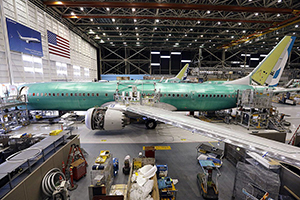
By Julie Johnsson
Bloomberg
Boeing is shrinking its Seattle-area workforce by at least 1,800 jobs this year as the company streamlines operations in a brutally competitive commercial-aircraft market.
The planemaker approved voluntary layoffs for 1,500 mechanics, according to a person familiar with the situation who asked not to be named because it hasn’t been made public. Another 305 engineers and technical workers are leaving voluntarily, Bill Dugovich, a spokesman for their union, said Thursday.
Boeing told employees in December that it would seek buyouts as part of an effort to cut costs and match employment to market requirements, company spokesman Paul Bergman said by email. Boeing also plans to cull commercial-airplane jobs by leaving open positions unfilled and through involuntary layoffs, he said. He declined to say how many buyouts have been approved.
The Chicago-based manufacturer has been winnowing employment in the Puget Sound area, its largest industrial base, over the past year as sales slowed for the jetliners, which accounted for 69 percent of total revenue last year. Boeing has trimmed its Washington state workforce by 9.2 percent to 71,036 since the start of last year even as Chief Executive Officer Dennis Muilenburg has emerged in meetings with President Donald Trump as an advocate for U.S. manufacturing.
Those earlier cuts included about 1,000 members of the International Association of Machinists and Aerospace Workers and 850 members of the Society of Professional Engineering Employees in America who applied for voluntary layoffs. Another 350 SPEEA members lost their jobs involuntarily, Dugovich said.
Boeing officials last week told the engineering union to “expect a similar reduction in workforce in our units as we experienced last year,” he said.
http://www.heraldnet.com/business/boeing-cutting-1800-seattle-area-factory-engineering-jobs/
Published February 17, 2017 by King 5 News
Safety Failures Lead to ‘Death Sentence' at Hanford
 Dave Aardal conducted some of the most dangerous work at Hanford during his ten years of employment at the former nuclear weapons production facility. Part of his job included training on safety measures and equipment, during which he was assured that following the protocols would keep him safe from toxic chemicals and radioactive waste.
Dave Aardal conducted some of the most dangerous work at Hanford during his ten years of employment at the former nuclear weapons production facility. Part of his job included training on safety measures and equipment, during which he was assured that following the protocols would keep him safe from toxic chemicals and radioactive waste.
But six years after being removed from his job by Hanford medical professionals due to illness, Aardal, a 45-year-old father of three, is gravely sick and dying from a rare illness called chronic beryllium disease (CBD).
There is only one way to contract CBD: A person must be exposed to too much beryllium -- a highly toxic metal used in the production of nuclear weapons.
The U.S. Department of Energy, which manages the Hanford cleanup, concedes many facilities there has been significant beryllium contamination. And outside of some aerospace jobs in Western Washington, Hanford is one of the only places in the state where beryllium exists in sufficient quantities to pose a threat to health.
After Aardal’s diagnosis of CBD in 2008, he followed protocol and filed a workers compensation claim through the contractor tasked with managing the claims of Hanford workers, Penser North America. He believed approval would come quickly: When a person works at a site riddled with beryllium and is then diagnosed with CBD, top experts in the field say the illness should be presumed to stem from occupational exposure.
That’s not the way Penser and the Energy Department saw it. Penser’s medical professionals concluded that Aardal was ill with a different disease – sarcoidosis.
Sarcoidosis looks exactly like CBD, but it can’t be tied to occupational illness. In other words, Penser was telling Aardal he didn’t get sick from working at Hanford. Read entire article
Published February 15, 2017 at goiam.org
Boeing Workers in South Carolina Opt Against Union Representation
North Charleston, S.C., February 15, 2017 – Hourly production workers at Boeing’s South Carolina operations have voted not to join the International Association of Machinists & Aerospace Workers (IAM) at the present time.
“We’re disappointed the workers at Boeing South Carolina will not yet have the opportunity to see all the benefits that come with union representation” said IAM lead organizer Mike Evans. “But more than anything, we are disheartened they will have to continue to work under a system that suppresses wages, fosters inconsistency and awards only a chosen few.”
South Carolina has the lowest percentage of union members in the United States. North Charleston Boeing workers endured a multi-faceted anti-union campaign, which included captive-audience meetings and massive TV, radio and billboard ad buys.
“Boeing management spent a lot of money to make sure power and profits remained concentrated at the very top. The company’s anti-union conduct reached new lows,” said Evans. “The IAM remains committed to getting Boeing South Carolina workers the respect, wages and consistency they deserve.” Read entire article
Published January 30, 2017 at The Daily Caller
Public Opinion Shifts on Labor Unions Under Trump
By Ted Goodman
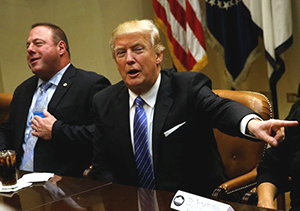
The public’s view towards labor unions significantly improved in the months before President Donald Trump announced his presidential run, and a new survey confirms the trend is continuing.
Sixty percent of adults today have a favorable view of labor unions, according to a new Pew Research Center survey released Monday. Public opinion towards labor unions have risen 12 percentage points since March, 2015, when just 48 percent of Americans had a favorable view towards labor unions.
President Trump’s campaign appealed to disaffected, rank-and file union members in the rust belt states, including Michigan, Pennsylvania and Wisconsin. While big labor bosses rushed to endorse former secretary of state Hillary Clinton, large swaths of working class voters were attracted to Trump’s message of “America First.”
The president’s victory came in large part to his appeal to Reagan Democrats in places like Macomb County, Michigan, where a large swath of the population blames trade deals like the North American Free Trade Agreement for widespread economic decay.
A CNN exit poll following the 2016 election revealed that Trump carried 42 percent of voters in union households, compared to former Secretary of State Hillary Clinton’s 51 percent. Trump’s positive numbers with unions are unheard of for Republican candidates since Reagan.
The survey measured the American public’s view towards labor unions and corporations. Fifty-six percent of American adults had a positive view toward corporations, which is an 8 percent jump from March, 2015. According to the Pew survey, the public generally held a favorable view towards both labor unions and corporations during the early 2000s, but those views soured during the great recession. Read entire article
Published February 1, 2017 at Teamster.org
Bill Would Help Ill Hanford Workers Get Compensation
By Annette Cary

Hanford workers would receive the same protections as firefighters in Washington if they developed serious illnesses, under a bill submitted Thursday for consideration by the state Legislature.
The extra protection is needed because of a lack of real-time monitoring and data for chemical vapors at the Hanford tank farms, said Nick Bumpaous, vice president of the Central Washington Building Trades.
Workers who become seriously ill after exposure to chemical vapors have trouble providing the proof needed to get a workers’ compensation claim accepted, he said.
Penser North America administers the Hanford workers’ compensation program, and the Washington State Department of Labor and Industries allows or denies claims.
“My entire concern is supporting worker safety,” said Rep. Larry Haler, R-Wash., lead sponsor of the House bill and a past Hanford worker for 40 years.
He sees the bill as a step toward getting to the bottom of resolving the safety issue.
Three more Hanford workers reported suspicious smells that could be from chemical vapors Thursday afternoon at Hanford. Nine workers reported suspicious odors the day before outside a Hanford tank farm.
Workers are concerned that exposure to the chemicals could lead to serious health issues, including neurological and respiratory diseases.
The bill would require the workers’ compensation program to presume that a wide range of diseases were caused by occupational exposure. Read entire article

